
Wine Culture and Information since 2002 - Volume 22
 Wine Culture and Information since 2002 - Volume 22 |
|
Issue 125, January 2014 |
Contents |
|
|
Dear Wine... |
|
Dear wine I am writing you. It is now a long time, through the pages of this editorial, each month I write about you, of the facts concerning your world and about my opinions. A moment in which I share my thoughts with others. Maybe it is because another year has just passed - 2013 has just ended and welcomed 2014 - or maybe for the fact in this period one is used to draw conclusions, by considering the good things and the less good ones, so I thought I would have written you. We now know each other, through these pages, since twelve years, however we know each other for a truly longer time. You know, the ones who are born in this country - Italy - and the same happens in others places of the world as well, learn to live a daily life with you, with the beverage strongly distinguishing our culture. I do not have the presumption, of course, to know you very well, I cannot say I know everything about you and of your practically endless souls. You are a noble artist of the land and with each of them you renew your promise of union, year after year, always changing yourself although remaining always the same. To really know you well is not that simple. We met so many times I now forgot how many times this happened. You have always been a loyal fellow, I always respected you, without abusing of you in the excess and I wanted the very same from you in return. After all, I have never appreciated those who, in a foolish and insane way, abuse of you, as I find this to be unfair and unseemly, both for you and for the ones who believe it is useful abusing of your virtues. I guess the ones who make it may also believe they are intelligent and smart: frankly speaking, I have never understood how they can believe that, I find this to be very difficult to understand. To me, it is like trampling on history, a long and important culture for humanity, a tale of the land telling the man the strength and generosity of Nature. I guess you are not surprised by that, as, unfailingly, you never respect the ones who do not respect you. On this regard, you are very coherent and loyal: when someone considers your value and enjoy your virtue with respect, you are always grateful and generous in telling noble stories and giving amazing emotions. There are other ways to not respect you and this too can be considered an abuse or, even worse, an abomination. Producers with no scruples use you as a mean way of speculation: they praise the land, talk about a non better specified traditions and abuse the word “quality”. They have the nerve for that, as they have never entered their vineyards, their lives are so distant even from the most recent traditions, quality is a word used to tell a piteous tale. The same nerve, nevertheless, have those who use vineyard and wine in order to glorify themselves only. They believe they are always right, they are strong of a sad and hypocrite presumption, always ready to deny the wine of others even when they do not know it at all. In case you try to contest their wine, even in the slightest way, it is the beginning of an endless war, useless massacres of glasses, bottles and words. They do not understand that, at the end, everyone is losing and there is no winner. Then, there are the ones who use words for their own personal pleasure: expressions of vanity which seem to talk about wine but they are instead a sad expression of presumption in the form of absolute and undeniable verdicts. Who knows what do you think about them, dear wine, of those funny subjects who talk, or better to say, they run you down, while they are convinced of being in the supreme pulpit and that everything depends on their sacred words. I am sure you would laugh at them and, after that, you would continue your journey, being aware that, most of the times, those words are incomprehensible even to those who write or speak them. After all, you are interested in earth, mother vineyard, your nature of beverage which is such thanks to the intervention of man who understood, with time, Nature's processes and interacts with them for his own pleasure. Yes, I agree, this is a selfish act that, I am sure, you fully understand because of the joy and emotions you are capable of giving to the ones who know how to listen to you. 2013 has just passed, a year which witnessed, once again, idealogical fights that, according to the challengers, they were supposed to be useful in supporting wine and its identity. This has not been different from the past years, after all, it was not so different from the past. I understand the subject “wine” is something strongly felt, strongly associated to local cultures of every country, and sometimes we end up to blindly defend a principle and a concept without listening to others. Sometimes it seems for wine the famous saying grass is always greener on the other side of the fence is not valid: sometimes, not only the grass on the other side is less green, but it is also ugly, withered and of disputable dignity. I am not simply talking about different countries of the world, as this seems to frequently happen for producers of the same area, even “vineyard neighborings”. Unity is strength: not so many have understood this and, besides few enlightened examples, there are many who fight each other for nothing. I do think, dear wine, you would be successful in getting everyone along, beyond words and arguments: in good company and a good glass, most of the times, it is easy to make friends. This is what I am wishing you for 2014. I wish they will let you freely speak for what you are, for all of your different ways of being, always different but all children of the same soul. After all, this is what I like about you, dear wine, your versatile personality, your endless nuances and the many ways you can be interpreted and considered. In case it would not be like that, we would all be happy of drinking any other beverage - always the same and never changing - and there would not be any argument or fight. On this regard, you perfectly reflects the forms and substances of the world: everything looks different according to a point of view, from where and how one's look at it. Nevertheless, nothing is absolute, everything is relative, and you are no exception to this. The best does not exist. Let's make in 2014 will simply exist wine, yourself for what you are, what you express and for how they give you live. This is my wish for you, dear wine. In the meantime I am going to listen to your answer by appreciating the aromas of this generous glass I have here, right by my side. I know, in the wisdom of moderation and humbleness of listening, you will not disappoint me. Antonello Biancalana
|
||||
Soil, Minerality and WineThe type of soil in which the vine is cultivated affects the organoleptic qualities of wine. Minerality, frequently associated to the soil, has no connection with it |
|
Soil represents one of the fundamental elements of viticulture. It is not by chance, in fact, grape varieties to be planted in a vineyard, and - in particular - their rootstock, are chosen in function of this factor. It is commonly known that, after the devastation of phylloxera - which brought up concrete risks for viticulture in Europe - all the grape varieties are grafted to a rootstock capable of resisting to the attack of this aphid. This also allowed varieties to adapt to different environmental conditions, by significantly interacting with the capability of the vine in absorbing minerals and nutrients, as well as ensuring a good supply of water. This factor, in addition to the geological characteristics of the soil, allows the vine to generate different expressions, sometimes even distant, however according to soil and environment. To the soil is recognized, frequently and mistakenly, the capacity of giving the wine organoleptic qualities which are generally defined as mineral. The concept of minerality in wine, although this is well defined and perceivable to the senses of a taster, has no concrete and scientific explanation which can clear the origin of this sensation. Before defining, at a sensorial level, what is minerality in wine, let's try to clear the reason why it has no connection with the soil in which a vine is cultivated. It should however be noticed the sensation of minerality is sometimes perceived in wines produced from grapes of vineyards cultivated in particular soils, such as volcanic soils, for example. If for “mineral” we consider a sensation produced by a mineral salt or elements, and supposing they are absorbed from the soil by the vine and reach berries, it should be noticed the quantity contained in grape juice is pretty negligible. The concept of minerality in wine is generally defined by the olfactory sensations associated to some stones and minerals - such as flint - as well as some metals. Some support the idea minerals and metals do not have a proper smell, indeed this theory can be easily denied by facts, for example by the smell produced by scratching flints. Also stones heated by the sun, or wet by water, generate their characteristic smell. Finally, some tasters classify as mineral the aromas of sulphur, tar, smoke and burnt rubber, sensation we believe should be classified differently. Some also believe minerality is associated to the gustatory sensation of salinity, typical in certain wines produced from vineyards cultivated along the sea or however affected by the strong influence of sea breeze. It must be noticed the salty sensation produced by certain wines - and of disputable association to the concept of minerality - does not correspond, as believed by some, to the sapidity of wine. The term minerality, referred to wine tasting, is however associated to many olfactory and gustatory stimuli, frequently of purely subjective attribution, and get different and subjective meaning also among wine tasters. For some, minerality is associated to the crispness of a wine, for others it corresponds to wine's finesse, other, finally, associate minerality to the so called taste of terroir, that is the overall organoleptic sensations expressed by a wine of a specific territory. Science does not help to explain the concept of “minerality”, as there are no tangible proofs about the relation of wine components and the perception of this sensation. It should however be noticed the most reliable scientific hypothesis supports the idea minerality is produced by some sulfur compounds in their reduced form and developing according to variety and aging.
If it is true minerality has no connection with the soil and the qualities this can give the wine, it is however undeniable its composition affects organoleptic characteristics, from appearance to taste. It is not the only factor capable of giving wine its personality and its peculiar characteristics, it however represents one of the fundamental factors. Not all the soils are the same, not all grape varieties are the same. There are grapes making better wines in specific type of soils, whereas in others the make, not only ordinary results, but also disappointing wines. The variability of the result, besides the conditions of the soil and environment, are strongly conditioned by vine's rootstock which - like already said - it is chosen also according to the composition of soil. The composition of soil, as well as environmental and climate conditions, directly affects the organoleptic qualities of wine and interacts with the biologic cycle of vine. The influence of soil in wine affects all of its sensorial aspects. Wine appearance and its color, as well as the development of certain aromas and specific gustatory qualities, have a direct connection with the characteristics of soil. We will in fact see later, every type of soil - having proper geological characteristics - substantially affects the wine which can be obtained from the same variety, producing, in most of the cases, results even distant one from each other. By considering the specific types of soil and their effects on wine, it should be noticed the result is also in function of vine's rootstock. The same vine, grafted to different rootstocks, in fact gives different wines also when planted in the same soil and in the same vineyard. We will not discuss about the agronomic effects and consequences of the soil in vine cultivation, although we will discuss some fundamental elements, we will mainly talk about the influence of soil in wine's organoleptic qualities. From an agronomic point of view, soil is the fundamental support of a vine, in which the plant sets it roots, in order to ensure a proper support as well as for the supply of nutrients, mineral and water. Like already said, mineral substances absorbed by the vine from the soil - which some believe to be responsible for the minerality of a wine - do not have a connection with this organoleptic descriptor. If it is true part of the mineral elements absorbed from the soil reaches berries, and therefore the juice, the quantity found in wine is quite negligible to the sensorial perception. Vintners usually say vine, in order to give a quality wine, must suffer, that is it must be favored a condition in which it is forced to dig the roots in the deep of the soil in order to search for water and nutrients. This hypothesis has a concrete foundation, as wines produced in vineyards cultivated in very fertile soils have light organoleptic qualities, from appearance to taste. Vintners are always contrary to the irrigation of vine, except when drought is a serious concern and could be a risk for vine's life, in order to “force” the vine to search for water in the deep of soil. On this regard it should be noticed DOC and DOCG production disciplinary of Italy expressly forbid the irrigation of vineyards. This is mainly forbidden in order to avoid a quantitative production of grapes, a factor that, unavoidably, is detrimental to wine quality. A soil suited to viticulture should have, among its main qualities, a good draining of water. Not only for the fact this forces the vine to search for water in the deep of the soil, but also for the fact it avoids roots to stay wet for a long time. We will not discuss about the physical and geological aspects of soil composition, however it should be noticed it is essentially made from skeleton, sand, clay and silt. Skeleton is made from elements of big size and having a scarce agronomic effects. Sand, clay and silt are made from very small particles and play important agronomic roles, both in terms of draining and absorption of water, as well as for soil porosity and its fertile characteristics. Types of soil differentiates one from each other by the variable presence of these elements, giving each of them proper agronomic and physical properties which will affect cultivation, yield and quality of vine and grapes. Clay is the most frequently found element in soil composition, also in terms of quantity. It has the property of absorbing water and of keeping organic substances, therefore making the soil pretty fertile. Grapes cultivated in soils rich in clay, give tannic wines, with intense color and low transparency, with good possibilities of long aging, pretty high content in alcohol, remarkable structure, good aromas and roundness. Lands rich in sand give the soil remarkable draining properties. Wines produced from grapes cultivated in this type of soil are characterized by pale colors and high transparency, good crispness, short potentials of aging, generally having a good elegance and fragrance of aromas, light body. In any case, excessively wet soils give wines with a pale color, lack of aromas and structure, short longevity and accentuated crispness. The same qualities, like already said, are found in wines produced in very fertile soils. Soil is not made by clay, silt and sand only. Also skeleton, therefore elements having a bigger size, interacts with the biological cycle of the vine and give wines specific qualities. Soils rich is schist, gravel, marl and slate, offer a good heat retention and reflect sun rays upwards. These characteristics are therefore useful to late ripening varieties, such as Cabernet Sauvignon, and favor the development of fruit and flower aromas. A soil rich in chalk - a classic example is the one in Champagne - reflects sun rays upwards to the vine, it is very soft and therefore roots can easily dig in the deep of soil. Moreover, chalk gives grapes a pretty evident acidity, an important quality for the production of sparkling wines. Other important elements of the soil are limestone and calcium carbonate. These elements generally give the wine intense aromatic qualities, with fine and elegant aromas, a moderate acidity and they are not always suited for a long aging. An excessively acidic soil makes wine with pale colors and the aromatic profile usually develops quite ordinary aromas, whereas to the taste it has a good crispness, as well as a lack of body and alcohol. The diversity of soil composition - therefore varying the presence of skeleton, clay, silt and sand - directly affects the organoleptic qualities of wine, appearance, smell and taste. Soil is integral and essential part of the terroir concept and, associated to all of the other characteristics making the environment and climate, allow the making of unique wines, unrepeatable elsewhere. Finally, the intervention of man can frequently change this balance. Soil can in fact be altered by changing its composition and, with that, the wine which can be obtained.
|
||||||||||||
Wines of the Month |
|
|
|
Score legend Prices are to be considered as indicative. Prices may vary according to the country or the shop where wines are bought |

|
|
Giada 2012 |
|
| La Costaiola (Lombardy, Italy) | |
| Grapes: Bonarda | |
| Price: € 7.00 | Score: |
| Giada shows a brilliant ruby red color and nuances of purple red, little transparency. The nose denotes intense, clean, pleasing and refined aromas which start with hints of cherry, blueberry and raspberry followed by aromas of violet, blackberry, plum and strawberry. The mouth has good correspondence to the nose, a crisp and properly tannic attack, however balanced by alcohol, good body, intense flavors, pleasing crispness. The finish is persistent with flavors of cherry, blueberry and raspberry. Giada ferments in closed tank. | |
| Food Match: Cold cuts, Pasta with meat, Sauteed meat | |
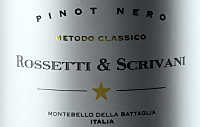
|
|
Rossetti & Scrivani Pinot Nero Metodo Classico Rosé |
|
| La Costaiola (Lombardy, Italy) | |
| Grapes: Pinot Noir | |
| Price: € 16.00 | Score: |
| Rossetti & Scrivani Pinot Nero Metodo Classico Rosé shows a brilliant pale pink color and nuances of pale pink, transparent, fine and persistent perlage. The nose denotes intense, clean, pleasing and refined aromas which start with hints of raspberry, tangerine and bread crust followed by aromas of strawberry, cherry, yeast, apple and hawthorn. The mouth has good correspondence to the nose, an effervescent and crisp attack, however balanced by alcohol, good body, intense flavors, agreeable. The finish is persistent with flavors of raspberry, cherry and tangerine. Rossetti & Scrivani Pinot Nero Metodo Classico Rosé referments in bottle on its lees for at least 18 months. | |
| Food Match: Pasta with fish, Sauteed fish, Sauteed white meat | |
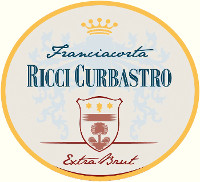
|
|
Franciacorta Extra Brut 2008 |
|
| Ricci Curbastro (Lombardy, Italy) | |
| Grapes: Chardonnay (50%), Pinot Noir (50%) | |
| Price: € 21.60 | Score: |
| This Franciacorta Extra Brut shows a pale golden yellow color and nuances of straw yellow, very transparent. The nose reveals intense, clean, pleasing, refined and elegant aromas which start with hints of mature banana, apple and bread crust followed by aromas of plum, hazelnut, honey, vanilla, flint, hawthorn, yeast, citrus fruits, grapefruit and butter. The mouth has good correspondence to the nose, an effervescent and crisp attack, however balanced by alcohol, good body, intense flavors, pleasing roundness. The finish is persistent with flavors of mature banana, apple and hazelnut. This Franciacorta Extra Brut referments in bottle on its lees for 42 months. | |
| Food Match: Roasted fish, Roasted white meat, Stuffed pasta, Fried fish, Broiled crustaceans | |
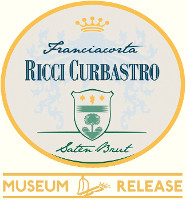
|
|
Franciacorta Satèn Brut Museum Release 2004 |
|
| Ricci Curbastro (Lombardy, Italy) | |
| Grapes: Chardonnay | |
| Price: € 25.00 | Score: |
| Franciacorta Satèn Brut Museum Release shows a brilliant straw yellow color and nuances of straw yellow, very transparent, fine and persistent perlage. The nose reveals intense, clean, pleasing, refined and elegant aromas which start with hints of apple, mature banana and bread crust followed by aromas of pear, acacia, hawthorn, yeast, honey, grapefruit, plum, praline, butter and hits of vanilla. The mouth has good correspondence to the nose, an effervescent and crisp attack, however balanced by alcohol, good body, intense flavors, agreeable. The finish is persistent with flavors of apple, ripe banana and plum. Franciacorta Satèn Brut Museum Release referments in bottle on its lees for at least 40 months. | |
| Food Match: Pasta with fish and crustaceans, Sauteed white meat, Broiled crustaceans, Stewed fish | |
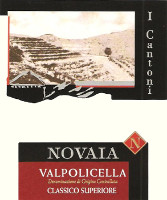
|
|
Valpolicella Classico Superiore I Cantoni 2009 |
|
| Novaia (Veneto, Italy) | |
| Grapes: Corvina (50%), Corvinone (30%), Rondinella (20%) | |
| Price: € 20.00 | Score: |
| Valpolicella Classico Superiore I Cantoni shows an intense ruby red color and nuances of garnet red, moderate transparency. The nose reveals intense, clean, pleasing and refined aromas which start with hints of plum, blackberry and black cherry followed by aromas of dried violet, blueberry, vanilla, tobacco, mace and chocolate. The mouth has good correspondence to the nose, a properly tannic attack and however balanced by alcohol, good body, intense flavors, agreeable. The finish is persistent with flavors of blackberry, plum and black cherry. Valpolicella Classico Superiore I Cantoni ages for 18 months in barrique followed by 6 months of aging in bottle. | |
| Food Match: Broiled meat and barbecue, Stewed and braised meat with mushrooms, Hard cheese | |
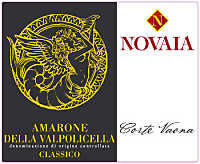
|
|
Amarone della Valpolicella Classico Corte Vaona 2008 |
|
| Novaia (Veneto, Italy) | |
| Grapes: Corvina (50%), Corvinone (25%), Rondinella (20%), Oseleta (5%) | |
| Price: € 35.00 | Score: |
| Amarone della Valpolicella Classico Corte Vaona shows an intense ruby red color and nuances of garnet red, little transparency. The nose denotes intense, clean, pleasing and refined aromas that start with hints of plum, blackberry and black cherry followed by aromas of dried violet, blueberry, tobacco, chocolate, vanilla and menthol. The mouth has good correspondence to the nose, a 5tannic attack and however balanced by alcohol, full body, intense flavors, pleasing roundness. The finish is persistent with flavors of blackberry, plum and black cherry. Amarone della Valpolicella Classico Corte Vaona ages for 24 months in barrique followed by 8 months of aging in bottle. | |
| Food Match: Game, Roasted meat, Stewed and braised meat, Hard cheese | |
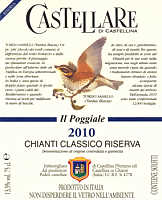
|
|
Chianti Classico Riserva Il Poggiale 2010 |
|
| Castellare di Castellina (Tuscany, Italy) | |
| Grapes: Sangiovese (90%), Canaiolo Nero (5%), Ciliegiolo (5%) | |
| Price: € 26.40 | Score: |
| Chianti Classico Riserva Il Poggiale shows an intense ruby red color and nuances of ruby red, little transparency. The nose denotes intense, clean, pleasing, refined and elegant aromas which start with hints of black cherry, plum and violet followed by aromas of blueberry, blackberry, vanilla, tobacco, cocoa, mace, pink pepper and menthol. The mouth has good correspondence to the nose, a properly tannic attack and however balanced by alcohol, good body, intense flavors, agreeable. The finish is persistent with flavors of black cherry, plum and blackberry. Chianti Classico Riserva Il Poggiale ages for 18 months in barrique followed by 12 months of aging in bottle. | |
| Food Match: Roasted meat, Braised and stewed meat with mushrooms, Hard cheese | |
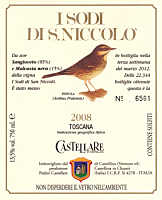
|
|
I Sodi di San Niccolò 2008 |
|
| Castellare di Castellina (Tuscany, Italy) | |
| Grapes: Sangiovese (90%), Malvasia Nera (10%) | |
| Price: € 51.70 | Score: |
| I Sodi di San Niccolò shows an intense ruby red color and nuances of garnet red, little transparency. The nose reveals intense, clean, pleasing, refined and elegant aromas that start with hints of black cherry, plum and blackberry followed by aromas of violet, blueberry, vanilla, tobacco, chocolate, pink pepper, leather, licorice, mace and menthol. The mouth has excellent correspondence to the nose, a tannic attack and however balanced by alcohol, full body, intense flavors, agreeable. The finish is very persistent with long flavors of black cherry, plum and blueberry. I Sodi di San Niccolò ages for about 30 months in barrique followed by 12 months of aging in bottle. | |
| Food Match: Game, Roasted meat, Stewed and braised meat, Hard cheese | |
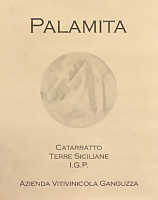
|
|
Palamita 2012 |
|
| Ganguzza (Sicily, Italy) | |
| Grapes: Catarratto | |
| Price: € 8.00 | Score: |
| Palamita shows a brilliant straw yellow color and nuances of straw yellow, very transparent. The nose denotes intense, clean, pleasing and refined aromas that start with hints of apple, plum and hawthorn followed by aromas of citrus fruits, peach, pear and almond. The mouth as good correspondence to the nose, a crisp attack and however balanced by alcohol, good body, intense flavors, agreeable. The finish is persistent with flavors of apple, plum and pear. Palamita ages for 5 months in steel tanks. | |
| Food Match: Pasta and risotto with fish, Sauteed white meat, Sauteed fish | |
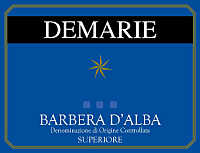
|
|
Barbera d'Alba Superiore 2011 |
|
| Demarie (Piedmont, Italy) | |
| Grapes: Barbera | |
| Price: € 9.60 | Score: |
| This Barbera d'Alba Superiore shows an intense ruby red color and nuances of ruby red, little transparency. The nose denotes intense, clean, pleasing and refined aromas that start with hints of cherry, plum and blueberry followed by aromas of violet, blackberry, vanilla and chocolate. The mouth has good correspondence to the nose, a properly tannic attack and however balanced by alcohol, good body, intense flavors, pleasing crispness. The finish is persistent with flavors of cherry, blueberry and plum. This Barbera d'Alba Superiore ages for 6 months in cask followed by 6 months of aging in bottle. | |
| Food Match: Stuffed pasta with meat, Broiled meat and barbecue, Stewed meat with mushrooms | |

|
|
Roero Riserva 2009 |
|
| Demarie (Piedmont, Italy) | |
| Grapes: Nebbiolo | |
| Price: € 15.20 | Score: |
| This Roero Riserva shows a brilliant ruby red color and nuances of garnet red, moderate transparency. The nose denotes intense, clean, pleasing, refined and elegant aromas which start with hints of cherry, plum and violet followed by aromas of blueberry, raspberry, vanilla, tobacco, rose, pink pepper, chocolate, mace and menthol. The mouth has good correspondence to the nose, a tannic attack and however balanced by alcohol, full body, intense flavors, pleasing crispness. The finish is persistent with flavors of cherry, plum and raspberry. This Roero Riserva ages for 12 months in cask and barrique followed by 12 months of aging in bottle. | |
| Food Match: Game, Roasted meat, Braised and stewed meat with mushrooms, Hard cheese | |
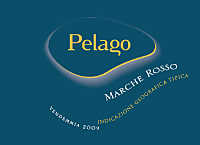
|
|
Pelago 2009 |
|
| Umani Ronchi (Marches, Italy) | |
| Grapes: Cabernet Sauvignon (50%), Montepulciano (40%), Merlot (10%) | |
| Price: € 22.00 | Score: |
| Pelago shows a deep ruby red color and nuances of ruby red, little transparency. The nose reveals intense, clean, pleasing, refined and elegant aromas which start with hints of black currant, plum and black cherry followed by aromas of violet, blackberry, blueberry, vanilla, tobacco, iris, mace, cocoa, leather and eucalyptus. The mouth has excellent correspondence to the nose, a tannic attack and however balanced by alcohol, full body, intense flavors, agreeable. The finish is very persistent with long flavors of black currant, black cherry and plum. Pelago ages for 14 months in barrique followed by 12 months of aging in bottle. | |
| Food Match: Game, Roasted meat, Braised and stewed meat, Hard cheese | |
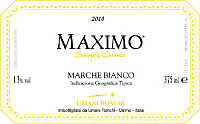
|
|
Maximo 2010 |
|
| Umani Ronchi (Marches, Italy) | |
| Grapes: Sauvignon Blanc | |
| Price: € 18.00 - 375ml | Score: |
| Maximo shows a deep golden yellow color and nuances of golden yellow, transparent. The nose reveals intense, clean, pleasing, refined and elegant aromas which start with hints of dried apricot, candied fruits and honey followed by aromas of lychee, raisin, peach jam, quince jam, citron, date, saffron, melon, citrus fruit peel and nail polish. The mouth has excellent correspondence to the nose, a sweet and round attack, however balanced by alcohol, good body, intense flavors, pleasing crispness. The finish is very persistent with long flavors of dried apricot, honey, lychee and raisin. Maximo ages for about 12 months in steel tanks. | |
| Food Match: Confectionery, Hard cheese | |
News |
|
In this section are published news and information about events concerning the world of wine and food. Whoever is interested in publishing this kind of information can send us a mail to our address.
|
Wine Parade |
|
|
| The best 15 wines according to DiWineTaste's readers. To express your best three wines send us an E-mail or fill in the form available at our WEB site. |
| Rank | Wine, Producer | |
|---|---|---|
| 1 |
| Camartina 2008, Querciabella |
| 2 |
| Brunello di Montalcino 2007, Donatella Cinelli Colombini |
| 3 |
| Verdicchio dei Castelli di Jesi Classico Superiore Podium 2010, Garofoli |
| 4 |
| Amarone della Valpolicella Classico Capitel Monte Olmi 2007, Tedeschi |
| 5 |
| San Leonardo 2006, Tenuta San Leonardo |
| 6 |
| Villa Gresti 2006, Tenuta San Leonardo |
| 7 |
| Trento Brut Riserva Methius 2006, Dorigati |
| 8 |
| Avvoltore 2009, Moris Farms |
| 9 |
| Langhe Riesling Herzu 2011, Ettore Germano |
| 10 |
| Trento Talento Brut Riserva 2007, Letrari |
| 11 |
| Brunello di Montalcino Vigna Loreto 2007, Mastrojanni |
| 12 |
| Sagrantino di Montefalco Collepiano 2007, Arnaldo Caprai |
| 13 |
| Confini 2007, Lis Neris |
| 14 |
| Franciacorta Pas Dosé Récemment Dégorgé 2006, Cavalleri |
| 15 |
| Offida Pecorino Colle Vecchio 2012, Tenuta Cocci Grifoni |
| |||||||
Privacy Policy | |||||||


| Copyright © 2002-2024 Antonello Biancalana, DiWineTaste - All rights reserved |
| All rights reserved under international copyright conventions. No part of this publication and of this WEB site may be
reproduced or utilized in any form or by any means, electronic or mechanical, without permission in writing from DiWineTaste. |